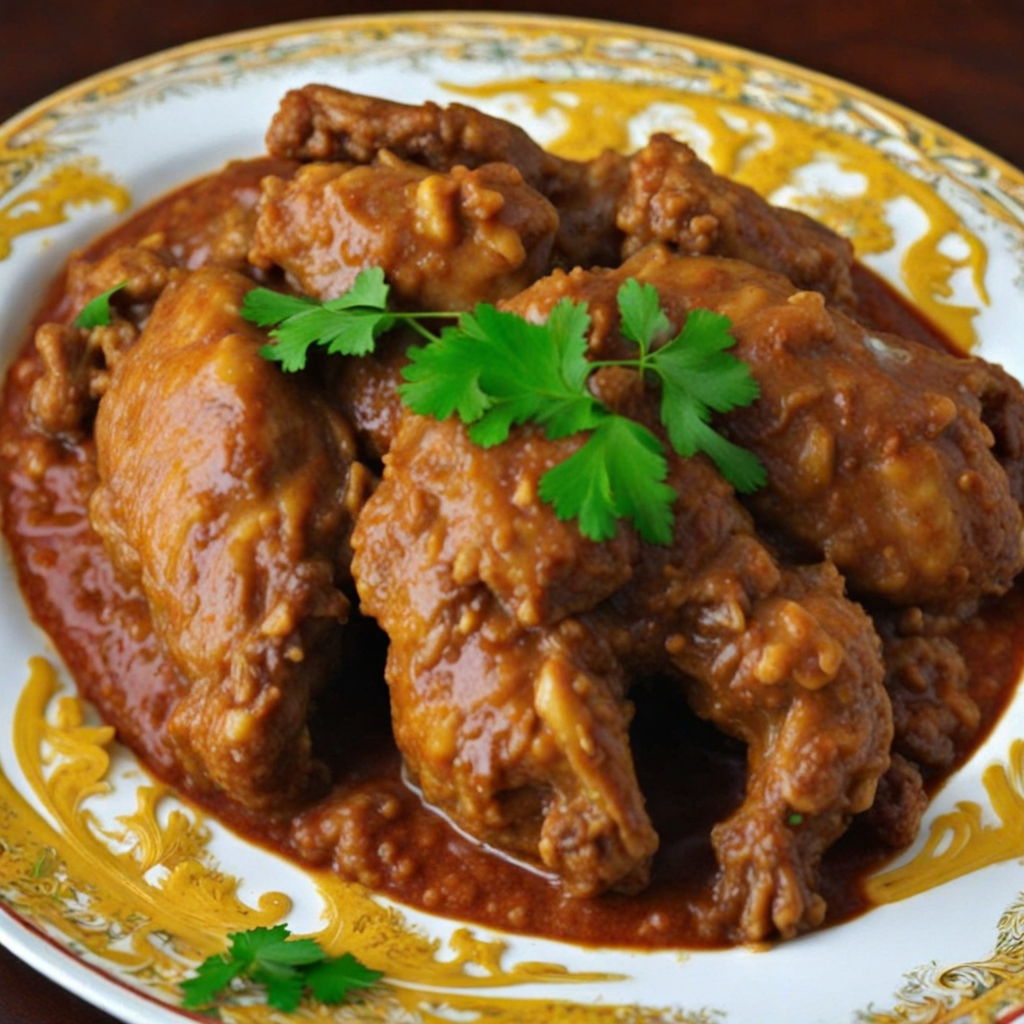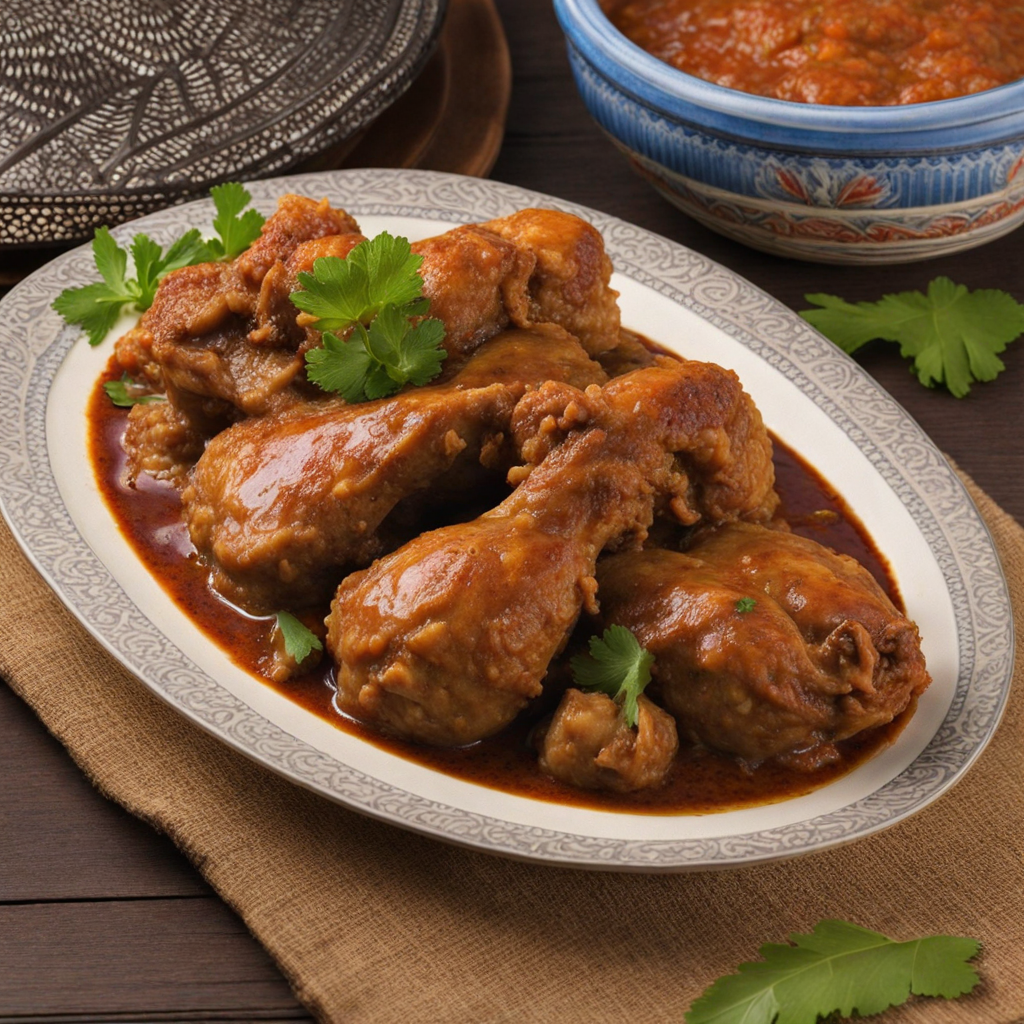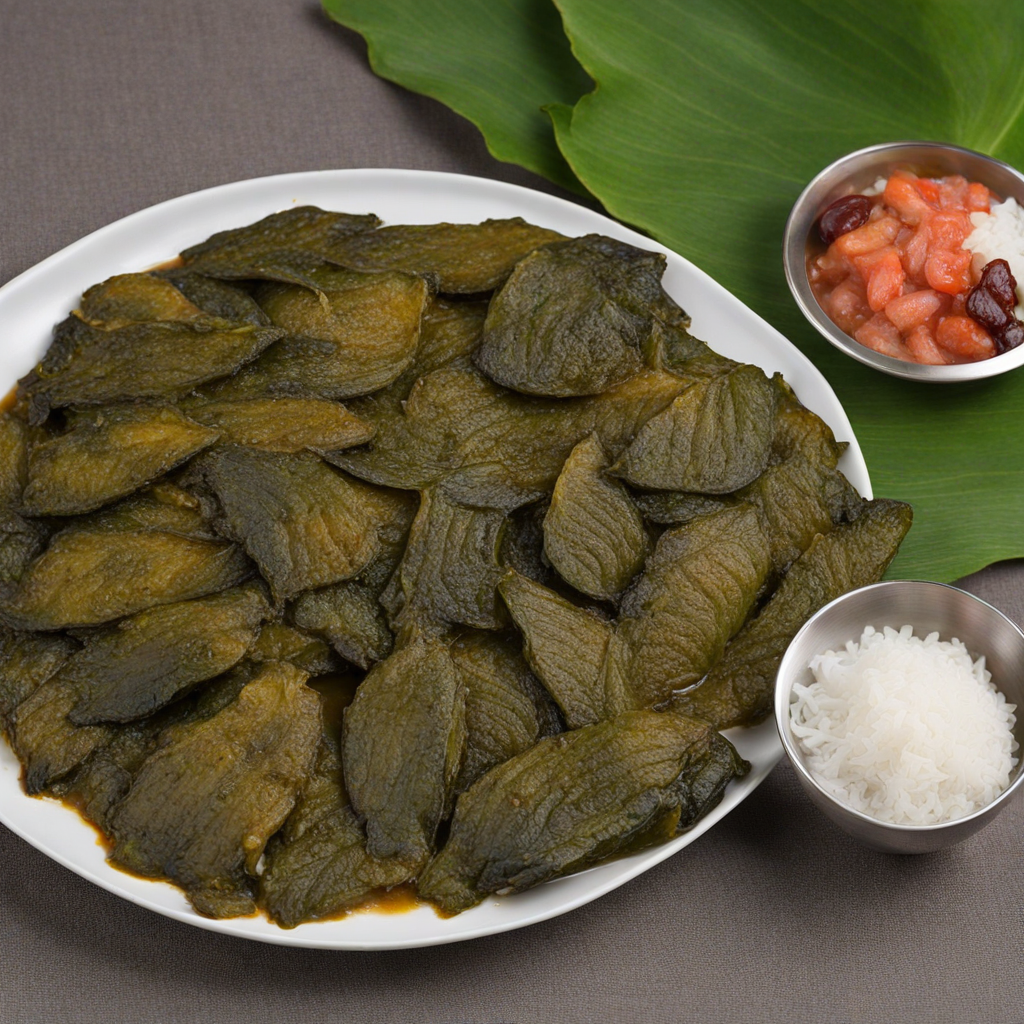Moambe Chicken
Moambe Chicken is a delightful dish that hails from the heart of the Congo, embodying the rich culinary traditions of Central Africa. At its core, this dish features chicken simmered to tender perfection in a luscious sauce made primarily from moambe, which is a palm nut puree. The sauce is thick, creamy, and packed with flavor, offering a unique combination of nutty, earthy, and slightly sweet notes. The chicken absorbs the vibrant flavors of the sauce, creating a harmonious balance that is both comforting and indulgent. The preparation of Moambe Chicken is a labor of love, often involving a variety of spices and ingredients that elevate its taste. Commonly, the dish is seasoned with garlic, ginger, and a hint of chili for a slight kick, while vegetables like onions and tomatoes add freshness and depth. Served with a side of rice, plantains, or cassava, the dish becomes a hearty meal that showcases the simplicity and richness of Congolese cooking traditions. Each bite is a journey through the flavors of the region, highlighting the importance of palm oil and local ingredients. In addition to its unforgettable taste, Moambe Chicken is often enjoyed in a communal setting, reflecting the culture of sharing meals among family and friends. This dish is not just food; it is a celebration of togetherness and heritage, making it a perfect choice for gatherings or special occasions. For those seeking to explore new culinary experiences, Moambe Chicken offers a taste of the Congo that is both exotic and deeply satisfying, inviting you to savor the essence of African cuisine.
How It Became This Dish
Poulet à la Moambé: A Culinary Journey Through Congo #### Origins Poulet à la Moambé, a signature dish of the Democratic Republic of the Congo, is more than just a meal; it represents the heart and soul of Congolese culture. Its origins trace back to the rich culinary heritage of the region, influenced by a variety of factors, including indigenous practices, colonial history, and trade. The name "Moambé" refers to palm oil, a key ingredient in this dish, which is a staple in many Central African cuisines. The use of palm oil can be traced back to the Bantu-speaking peoples, who have inhabited this region for centuries. The cultivation of the oil palm tree, native to West Africa, spread across Central Africa, where it became integral to local diets. The indigenous communities utilized the oil not only for cooking but also for traditional medicine and rituals. The preparation of chicken, or "poulet," is also significant. Chickens were domesticated in Africa thousands of years ago, becoming an essential source of protein. Their prominence in Congolese households reflects both practicality and cultural importance, as sharing a meal of chicken often symbolizes hospitality and community. #### Cultural Significance In Congolese culture, food is deeply intertwined with social rituals and celebrations. Poulet à la Moambé is often prepared during special occasions, such as weddings, family reunions, and religious ceremonies. The dish embodies the spirit of togetherness and is frequently served to honor guests, reflecting the importance of hospitality in Congolese society. The preparation of Poulet à la Moambé is a communal activity, often involving family members working together to create the dish. This process fosters connections and reinforces familial bonds, allowing for storytelling and the sharing of cultural traditions. Each family may have its unique take on the recipe, passed down through generations, which adds to the dish's cultural richness. The flavor profile of Poulet à la Moambé is a testament to the fusion of indigenous and colonial influences. Alongside palm oil, the dish typically includes ingredients such as peanuts, tomatoes, onions, and spices. The incorporation of peanuts, a product that was introduced to the region during the colonial era, highlights the adaptive nature of Congolese cuisine, blending local resources with new flavors. #### Development Over Time As with many traditional dishes, Poulet à la Moambé has evolved over time, adapting to changes in availability, tastes, and cultural exchanges. The colonial period, particularly during the late 19th and early 20th centuries, brought significant shifts to Congolese society, including the introduction of new ingredients and cooking techniques. During this time, European colonizers influenced local culinary practices, often introducing new spices and cooking methods. Despite these influences, Congolese people maintained their culinary identity, incorporating foreign elements in ways that complemented their traditional dishes. This ability to adapt while preserving cultural essence is a hallmark of Congolese cuisine, evident in the enduring popularity of Poulet à la Moambé. The dish's ingredients have also evolved due to globalization and the availability of various commodities. For instance, while traditional recipes primarily utilized local palm oil and peanuts, contemporary versions may incorporate coconut milk or even exotic spices from other parts of the world. This evolution reflects broader trends in global cuisine, where traditional dishes are often reimagined in response to new influences and preferences. In recent decades, as the Democratic Republic of the Congo has faced political and economic challenges, the role of food has taken on even greater significance. In times of strife, the preparation and sharing of traditional dishes like Poulet à la Moambé serve as a means of cultural preservation and resilience. The act of cooking and gathering around a meal becomes a form of resistance against the hardships of daily life, reinforcing identity and community. #### Poulet à la Moambé in Contemporary Congolese Society Today, Poulet à la Moambé remains a beloved dish in Congolese households and restaurants, symbolizing the rich culinary heritage of the nation. Its presence on menus, both within the country and in Congolese communities abroad, highlights the importance of sharing culture through food. Congolese diaspora communities have embraced this dish as a way to connect with their roots, often preparing it during cultural events and gatherings to celebrate their heritage. Moreover, the rise of food tourism in Africa has brought greater attention to traditional Congolese dishes. As travelers seek authentic culinary experiences, Poulet à la Moambé often emerges as a must-try dish, showcasing the unique flavors and cultural narratives of the region. This exposure has helped to elevate the profile of Congolese cuisine on the global stage, encouraging a renewed interest in its rich history and diversity. #### Conclusion Poulet à la Moambé is more than just a dish; it is a testament to the resilience, creativity, and cultural richness of the Congolese people. Its origins reflect the historical interplay of indigenous practices and external influences, while its ongoing evolution speaks to the adaptability of Congolese cuisine in a changing world. As a cherished symbol of community and hospitality, Poulet à la Moambé continues to hold a special place in the hearts and homes of those who prepare and share it. Through this dish, the legacy of the Congo lives on, connecting past and present, tradition and innovation, in a delicious celebration of life.
You may like
Discover local flavors from Congo







